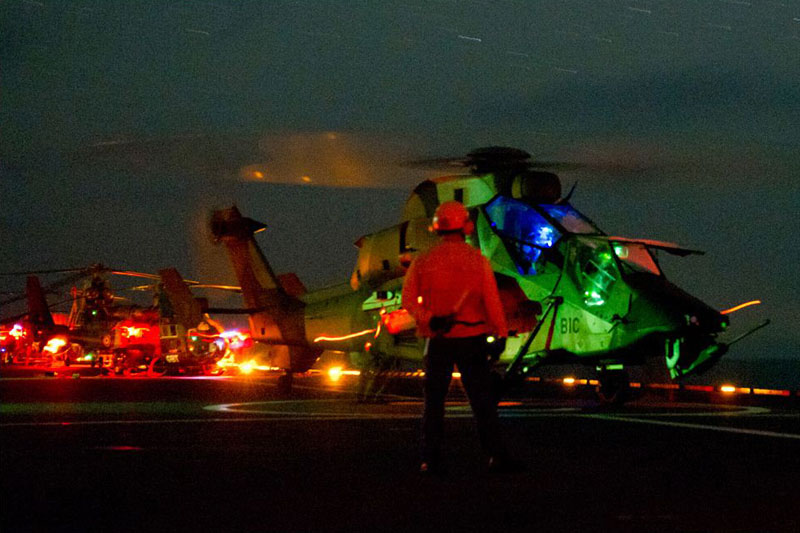The U.S. CENTCOM, in a
recent daily statement about U.S. activities against Islamic State, unveiled a
strike made by an attack helicopter against targets West of Baghdad on October
4, 2014. If the official report provided no details about the type of helicopters,
Defense online magazines indicated that they were likely AH-64 Apache
helicopters deployed to Baghdad International Airport in July to initially provide
protection to U.S. facilities.
The first strike by
those types of assets, during an Air-Power-centric campaign, reminds the use of
French and British attack helicopters during the 2011 Libyan campaign. The deployment
of those Land-Power-centric assets aimed to break a stalemate that a
predominantly air campaign (without enough local troops on the ground for
intelligence or kinetic actions) could not solve wholly by itself.
The Islamic State was
an adaptive opponent with changing tactics in the wake of the current U.S.-led
bombing campaign by dispersing or hiding their troops and civilian-made technicals with low-profile tactics to
avoid ISR detection and air strikes. As Clausewitz Prussian thinker describes under
the name of “constant reciprocal actions”, if the enemy is adaptive, Blue
Forces are too, or must be too; the war is a duel.
After two months of air strikes against the Kaddafi’s regime troops, British
and French government’s planned on May 2011 to provide a different military approach
to create a tactical breakthrough on the ground and to avoid a political and
military sinking with an air campaign whose tempo weakened due to lack of effective
targets. Any resemblance to actual events or people is purely coincidental, of
course.
According to military
planners of Operation Unified Protector (OUP) over Libya, attack helicopters
would provide more precision strikes than fighter aircrafts currently used, through
a lower altitude flight that allows discovering camouflaged targets. If Libya -
and Iraq - was a high threat environment for attack helicopters (with SA-7 or
ZPU systems and other anti-aircraft weapons), the risk was considered acceptable
as it was believed that their presence achieved considerable psychological
effect for allied troops.
The British Army
fielded four AH-64 Apache and the French Army provided eighteen helicopters for
a Helicopter Strike Group with EC-665 Tigre HAP (without Hellfire or Spikre ER
anti-tank missiles), SA330 Puma helicopters for CSAR missions and air
coordination headquarters, and SA341/342 Gazelle
armed with HOT anti-tank missiles. Army Air Corps AH-64 flew from the Royal
Navy’s helicopter carrier HMS Ocean while Tigre operated from the amphibious
helicopter carriers Tonnerre and Mistral during littoral operations.
Nevertheless, the
French and British tactical approaches were a bit different during raids which begin in early June. British one was more
traditional with attack helicopters used at a highest altitude than French
assets to strike targets at a safety distance with mainly deliberate targeting.
French Army tactics (the concept of “aérocombat”) were a “vampire approach”, as a French pilot officer said, during
hunt-night raids on specific “kill boxes” areas. French pilots make dynamic targeting
with a very useful “cockpit delegation” rules of engagement. This track and
target approach allows strikes on targets blended with population at a
proximity range without Forward air controllers (FAC) on the ground.
Over the seven-month
course of air-campaign, the operation involved over 26,000 sorties of which
around 25,000 were flown by fixed wing aircraft with more or less 500 by
helicopters (and 500 by unmanned air vehicles). 22 Apache missions (or 49
combat sorties) from the sea were flown with 99 Hellfire missiles fired along
with 4,800 rounds of 30mm cannon and 16 CRV7 rockets, for 116 targets engaged. The
French helicopters flew 450 sorties (4.5%) but destroyed no less than 550 targets
(nearly 10%,), expending 431 HOT plus an unspecified number of 68 mm rockets
and 20 mm rounds.
Thus, Libyan
air-campaign was not only a framework for joint operations with Arab partners
as the use of Qatari Mirage 2000-5s and Emirati F-16E/F Block 60 or Mirage 2000-9s
for ground strike or air-to- air missions, but also a framework for an adaptive
air-campaign with fixed and rotary air assets to break the resistance and the
opponent victory momentum at the tactical level, to boost the maneuver at the operational
level, and to strengthen the credibility of British and French troops at the
strategic level.
The main risk for the
Iraqi campaign is currently not a stalemate because various military options
have not yet been used, but to be caught in a circle with a "mission creep" and a
too much differential between goals and (inadequate) means. To avoid such a political
and military risk, a dynamic use of assets is maybe necessary for the U.S.-led
coalition with deployment of new ones and removal of others in the coming months. To be continued.
An other column in English on Mars Attaque. An other try to share my articles to a non-French speaking audience (at a twice-monthly or monthly rate, I don't know yet) ... and a need also to improve my writing skills in English with exercices.
An other column in English on Mars Attaque. An other try to share my articles to a non-French speaking audience (at a twice-monthly or monthly rate, I don't know yet) ... and a need also to improve my writing skills in English with exercices.



2 commentaires:
Bonsoir. Je signale une faute de frappe à Tonnerre.
Merci. Toujours attentif...
Enregistrer un commentaire